Cold War USN Aicraft Carriers
 Circa 85 ships 1945-today
Circa 85 ships 1945-today
Cold War USN Carriers:
Essex SBC-27 class | Saipan class CVs (1945) | Midway class | USS United States | Forrestal class | Kitty Hawk class | USS Enterprise | Nimitz class | Gerald Ford classAssault Carriers:
Iwo Jima class | Tarawa class | Wasp class | America class | SCS class | VSS classThe bulwark of the “free world”
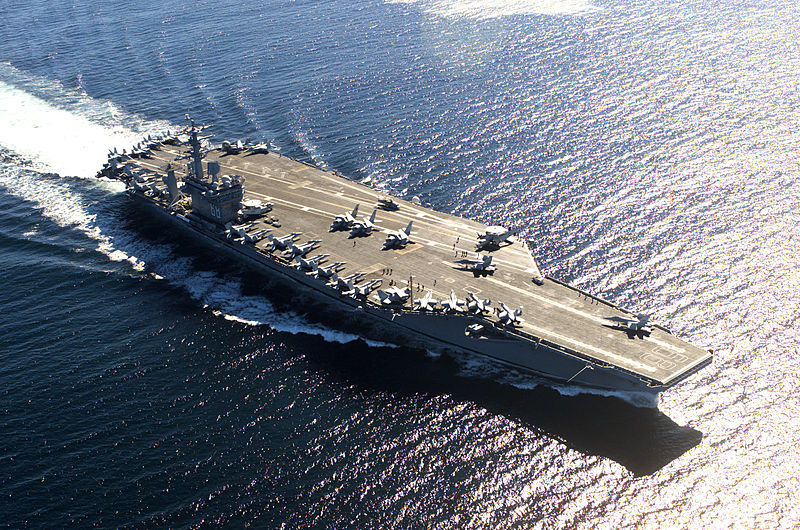
For 43 years, NATO’s safety and strength rested on the shoulders of US Navy task forces, centered around its mighty aircraft carriers. By their numbers and size, they dictated the composition, procurements, doctrine, strategy of the surface fleet alongside the SSBN deterrent force from the 1960s. They were the supreme projection of power, nin-nuclear deterrence complement and an essential tool in the White House’s displomacy for decades, and still is today.
In the 1950s were developed “supercarriers” better suited for jets, after the numerous Essex-class were rebuilt and modernized, used well into the late 1970s, the record being granted to the USS Midway, in service by 1945 and retired in 1990. The Forrestal and Kitty Hawk classes were conventional super-carriers, USS Enterprise the first nuclear aircraft carrier, followed by the Nimitz class, which carried out new task forces until after the end of the cold war, and the next generation, Gerald Ford class.
However this is not only about the ships themselves. Around these fantastic vessels, the mightiest, largest ever built, were nothing without a whole ecosystem, their own escort, operative concepts around these, and of course development of naval aviation. This part will be seen in the second part of this article.
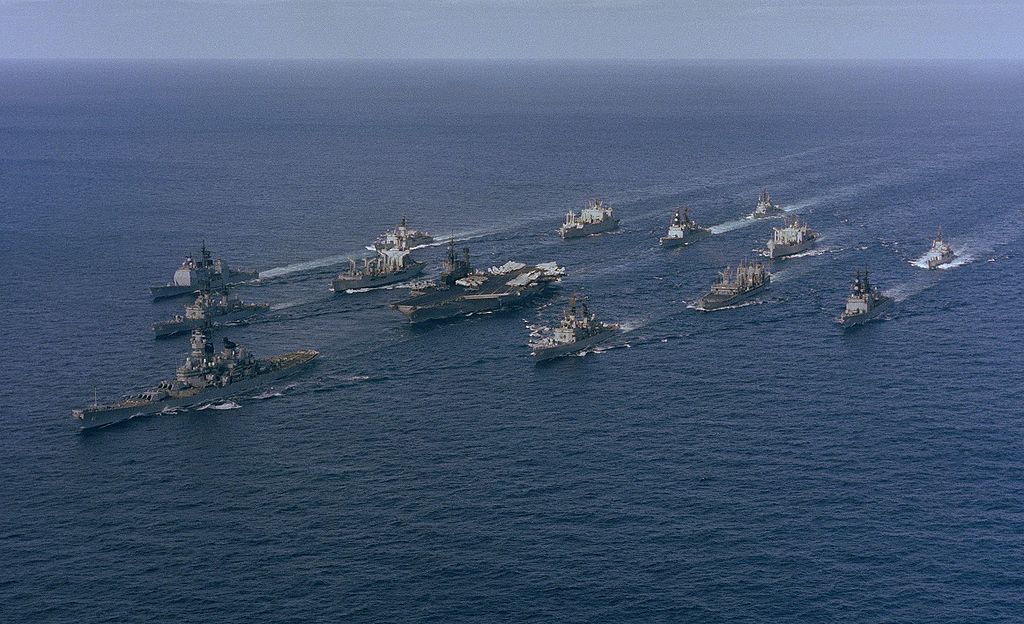
Battle Group Alpha Midway Iowa underway 1987
Nomenclature of aircraft carriers
 Essex class aircraft carriers (1942)
Essex class aircraft carriers (1942)
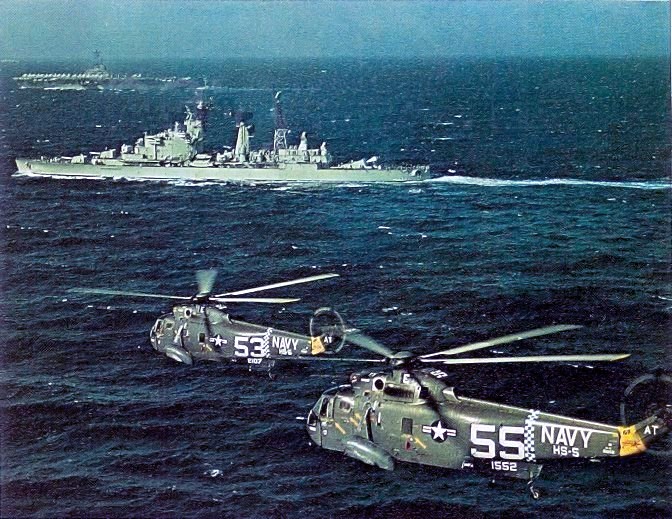
The Essex class was a class of aircraft carriers used by the United States Navy during World War II and the post-war era. These carriers were designed to replace the earlier Yorktown class and were the largest class of carriers built by the United States during World War II.
The Essex class carriers were approximately 872 feet long and had a displacement of about 27,000 tons. They were powered by eight boilers and four steam turbines, which gave them a top speed of over 30 knots. The carriers had a crew of around 2,600 and could carry up to 100 aircraft.
The Essex class carriers were instrumental in the Pacific theater of World War II, participating in many major battles such as the Battle of the Philippine Sea and the Battle of Leyte Gulf. They also saw service in the Korean War and were used as training carriers in the post-war period. Several Essex class carriers were also modernized and converted to serve as amphibious assault ships during the Vietnam War. Overall, the Essex class was a highly successful and influential class of aircraft carriers, which size and number was well capitalized on in the following decades.
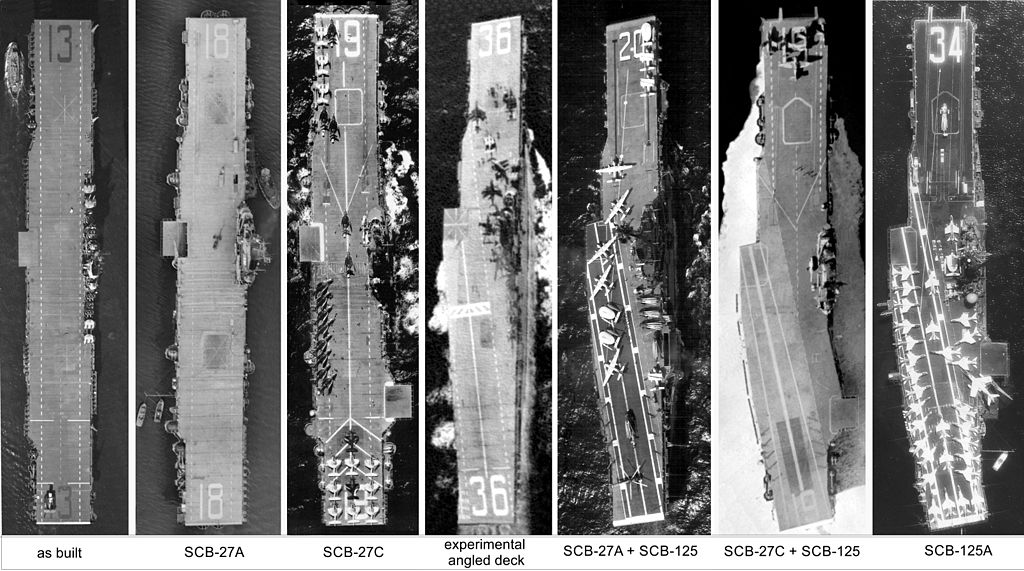
The Essex class were modernized in two phases to stay active during the cold war, some reaching 40 years of service or more:
Indeed both them and the Midway-class sustained the USN air power until the late 1950s, through the Korean War and practically until the end of the Vietnam War, as “only” the four Forrestal and four Kitty Hawk were completed in between. The larger Midways soldiering until the gulf war. Their spacious hangars was good enough for ealry jets and their various modifications saw fifteen if them keeping up with their evolution like jet-blast deflectors (JBDs) as well as a far greater aviation fuel capacity and stronger decks, stronger elevators, the British optical landing system, new steam catapults and of course the new angled flight deck. It should be added that they diverged also between the “long” and “short” hulls, the latter being the earlier versions which flight deck was separated from the prow, unlike the “long” that were given a hurricane bow. In the end all were modified wich such a bow.
Eight of the last nine ships stayed on active duty and with three Midways from this postwar backbone, although under the Truman administration’s budget cuts, five went into mothballs in 1949, recommissioned during the Korean War and all but two short-hulls, plus thirteen long-hulls saw active Cold War service.
SBC-27A
USS Oriskany (unfinished at the end of the war) was completed to an improved design until September 1950 with a new straight but reinforced flight deck, reconfigured island, and showed the first evolution of the type, retrofitted to eight earlier carriers. The Oriskany design was known as the SCB-27A program in the early 1950s.
SBC-27C
Six more of the earlier ships were later rebuilt to the improved 27C design (see later), seen as the last stage of the SCB-27 program, with steam catapults instead of the original hydraulic ones, but still the same original straight flight deck and reworked island.
SBC-125
The USS Antietam received an experimental 10.5-degree angled deck in 1952, which added to the enclosed “hurricane bow” became the trademark of the SCB-125 program, done along the last three 27C conversions. Thus later saw all the former SBC 27A and 27C ships (except Lake Champlain) ported to the new 125 standard. USS Shangri-La became the first operational angled deck carrier in 1955 but Oriskany, last angled-deck conversion received the SCB-125A refit, which equated the 27C standard plus with more powerful steam catapults and reinforced aluminum flight deck.
All in all, twenty-two of the twenty-four original Essex saw extensive service with modernizations and refits, the exception being the WW2 badly wounded veterans USS Bunker Hill and Franklin. The survived kamikaze strikes but were so damaged the commission estimated it was better to consider them as total constructive loss. They were never recommissioned.
CVS conversions
In 1955 seven unconverted Essexes were “converted” as anti-submarine warfare carrier (CVS) from August 1953. They could keep their straight flight deck but operated helicopters during the Korean War and received minor modifications for their operations.
The eight SBC 27A conversions also were later designated “CVS”, replacing the original seven unconverted ships which were pushed out of service in the late 1950s, sparing the cost of a long overhaul. Two SBC 27C conversions also bevame “CVS” in 1962 but CVS-11 USS Intrepid became an attack carrier in Vietnam, and two more followed in 1969.
SBC-144
In the end, all seven angle-deck 27As and one 27C were at last tailored for their role of CVS, being drydocked to have a bow-mounted SQS-23 sonar (SCB-144 program) in the early 1960s and they stayed operative until the 1970s and with the eight supercarriers making them obsolete, retired upt to the mid-1970s. However USS Lexington was kept until 1991 as a training ship, seeng many generations of planes and helicopters aboard. She was the only one active not only in WW2 and also the whole of the cold war. She was preserved as well as USS Yorktown, Intrepid, and Hornet. USS Oriskany survived into the 1980s but she was ultimately scuttled as an artificial reef off Florida in 2006.
SPH conversions
Three unmodernized Essexes (USS Boxer, Princeton, and Valley Forge) were redesignated Landing Platform Helicopter (LPH) donated to the USMC as amphibious assault ships, carrying helicopters for support and airborne assault and used in Vietnam, until the mid-1970s. Later they were reclassified as aircraft transports (AVT). On of these was also offered to the Royal Australian Navy in 1960 to replace HMAS Melbourne but declined due to compatibility issues and cost.



 Midway class aircraft carriers (1945)
Midway class aircraft carriers (1945)
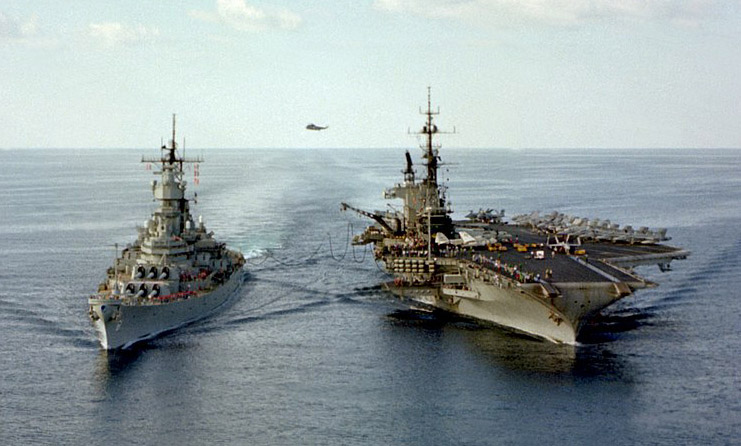
Original design
The Midway class was a class of aircraft carriers used by the United States Navy during the Cold War era. The class consisted of three ships: USS Midway (CV-41), USS Franklin D. Roosevelt (CV-42), and USS Coral Sea (CV-43).
The Midway class carriers were built to be larger and more capable than the previous Essex class carriers. They were approximately 1,000 feet long and had a displacement of about 70,000 tons. They were powered by four steam turbines and could achieve a top speed of around 33 knots. The carriers had a crew of around 4,500 and could carry up to 80 aircraft.
The Midway class carriers saw extensive service during the Cold War, participating in various conflicts and operations such as the Vietnam War, Operation Desert Storm, and Operation Southern Watch.
They also served as flagship vessels and played a key role in projecting American power across the globe.
After their retirement from active duty, the Midway class carriers were converted into museum ships. Today, the USS Midway is a museum ship in San Diego, California, while the USS Franklin D. Roosevelt was scrapped and the USS Coral Sea was sold for scrap.
SCB-110 reconstruction
During the 1950s, USS Midway and Franklin D. Roosevelt underwent the SCB-110 modernization program, similar to the Essex SCB-125 (reinforced angled deck, steam catapults, mirror landing system, stronger lifts and more avgas capacity, allowing them to operate heavy naval jets. USS Coral Sea was modernized later under the SCB-110A (angled deck at 3° more).
The carriers saw actuion in Vietnam War but by the late 1960s, their size prevented their scrapping. Still valuable as training aircraft, USS Midway was the first to undergo an extensive modernization called SCB 101.66 program. It became so controversial and expensive at 202 instead of the $82 million budgeted (Construction of JF Kennedy costed $277 million) this was not repeated on the other two. This enabled Midway to see the Gulf War and the end of the cold war, the last to be retired and later converted as museum ship.
 Saipan class aircraft carriers (1945)
Saipan class aircraft carriers (1945)

The Saipan class was a class of aircraft carriers used by the United States Navy during the Cold War era. The class consisted of two ships: USS Saipan (CVL-48) and USS Wright (CVL-49).
The Saipan class carriers were smaller than the Midway class carriers and were designed to serve as light carriers. They were approximately 600 feet long and had a displacement of around 14,500 tons. They were powered by four steam turbines and could achieve a top speed of around 33 knots. The carriers had a crew of around 1,200 and could carry up to 45 aircraft.
The Saipan class carriers saw service during the Korean War and the early years of the Vietnam War. They were also used for various other operations, including anti-submarine warfare and training exercises. The Saipan class carriers were eventually replaced by the larger and more capable Forrestal class carriers.
Both USS Saipan and USS Wright were decommissioned in the 1970s and subsequently sold for scrap.
Forrestal class aircraft carriers (1954)
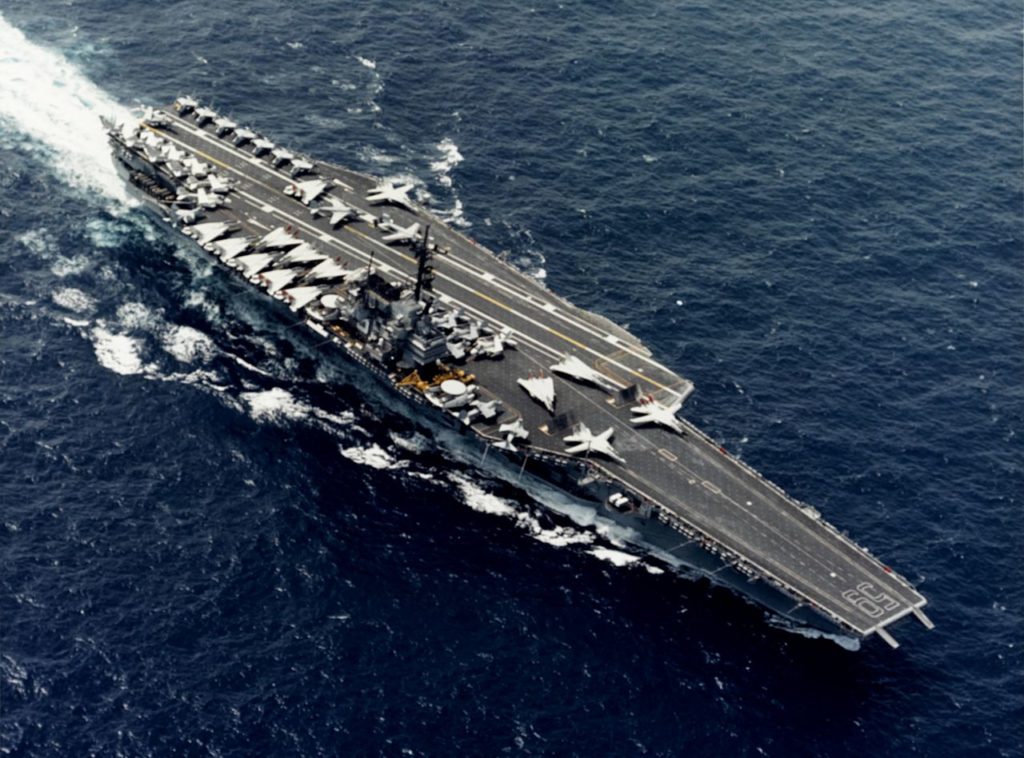
These four ships (USS Forrestal, Saratoga, Ranger and Independence) were built at Newport News and New York Dockyard in 1952-55, accepted into service in 1955-59. They were the first major aircraft carriers since the three Midways of 1945-47, and first “supercarriers”. They incorporated early lessons learned from the Korean War and drew a lot from the cancelled USS United States (1949) but much smaller in size. The Senate specified indeed a tonnage below 60,000 tonnes. Nevertheless, they had to integrate four new steam catapults capable of launching a new generations of Navy jets, and store twice as much fuel than the Midway. They were initially equipped with twin 3-in AA mounts, partly eliminated due to their sponsons causing excessive spray in heavy weather. Two Sea Sparrow launchers were eventually installed in 1972-77.
These ships had a busy life, notably soldering in Viet-nâm. USS Forrestal became sadly famous for a tragedy that occurred in June 1967 when during operations, while running out of ammunition, she was delivered with old WW2s stocks “Comp-B” model bombs. Unsecured, and with the oppressive heat, a short circuit caused the departure of a Zuni rocket from one parked Phantom II, striking at full force an A4 Skyhawk about to be catapulted with such vintage bombs underwing. The latter imediately caught fire, the bombs cooked off and exploded, while the pilot managed to escape. The devastating blaze swept over the other bomb-laden parked aircraft on deck, and turned into an inferno visible from dozens of miles around. A serie of nine devastating explosions spread through the hangars on the lower deck.
The crew, poorly trained for this type of that kind of disaster had trouble dealing with it, as available means proved insufficient. Finally at the cost of thousands of liters of seawater, Forrestal escaped total destruction. But the fire caused 132 dead and 62 badly burned. This remains a trauma in the US Navy, to such an extent that all aircraft carriers were equipped afterwards with much more substantial fire fighting means, and training became extremely extensive, better even than WW2 standards. Apart the tragedy of USS Enteprise, no such event ever happened again.

Author’s rendition of the Forrestal class
Characteristics (original):
Displacement: 61 163t, 78 509t PC.
Dimensions: 316.7 x 76.2 x 10.3 m
Propulsion: 4 HP turbines, 8 Babcock boilers, 4 propellers, 280,000 hp. and 33 knots max.
Crew: 2764 + 1912 (officers and sailors, air personnel)
Electronics: Radars SPS-8, 12. SPS58 (Sea Sparrow)
Armament: 8×1 76 mm AA, air group of 80-90 aircraft.
Armament (after modernization): 60 aircraft.
 Kitty Hawk class aircraft carriers (1960)
Kitty Hawk class aircraft carriers (1960)
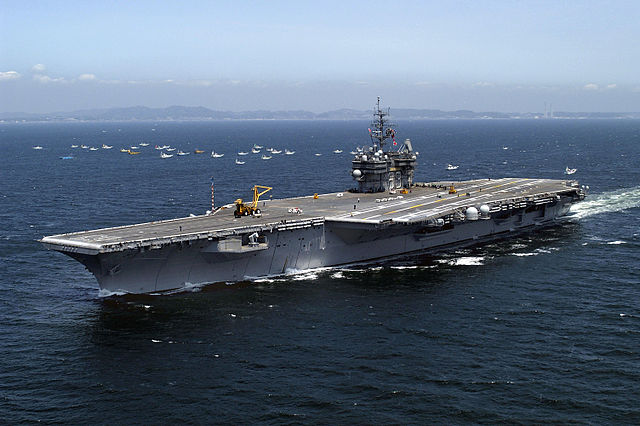
The Kitty Hawk class was a class of aircraft carriers used by the United States Navy during the Cold War and post-Cold War eras. The class consisted of four ships: USS Kitty Hawk (CV-63), USS Constellation (CV-64), USS America (CV-66), and USS John F. Kennedy (CV-67).
The Kitty Hawk class carriers were larger and more capable than the Midway class carriers they replaced. They were approximately 1,050 feet long and had a displacement of around 80,000 tons. They were powered by two nuclear reactors and could achieve a top speed of over 30 knots. The carriers had a crew of around 5,500 and could carry up to 90 aircraft.
The Kitty Hawk class carriers saw extensive service during the Cold War, participating in various conflicts and operations such as the Vietnam War, Operation Desert Storm, and Operation Enduring Freedom. They also served as flagship vessels and played a key role in projecting American power across the globe.
The USS Kitty Hawk was decommissioned in 2009 and was replaced by the USS George Washington (CVN-73), while the USS Constellation was decommissioned in 2003 and was scrapped in 2015. The USS America was decommissioned in 1996 and was sunk as a target in 2005. The USS John F. Kennedy was decommissioned in 2007 and is currently awaiting scrapping.
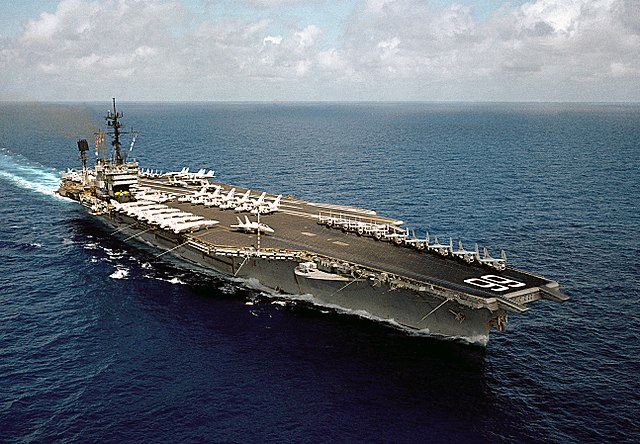
USS America underway in the Indian Ocean 1983

Author’s rendition of the Kitty Hawk class
Characteristics (original):
Displacement: 61 163t, 78 509t PC.
Dimensions: 316.7 x 76.2 x 10.3 m
Propulsion: 4 HP turbines, 8 Babcock boilers, 4 propellers, 280,000 hp. and 33 knots max.
Crew: 2764 + 1912 (officers and sailors, air personnel)
Electronics: Radars SPS-8, 12. SPS58 (Sea Sparrow)
Armament: 8×1 76 mm AA, air group of 80-90 aircraft.
Armament (after modernization): 60 aircraft.
USS Enterprise CVAN-65 (1960)
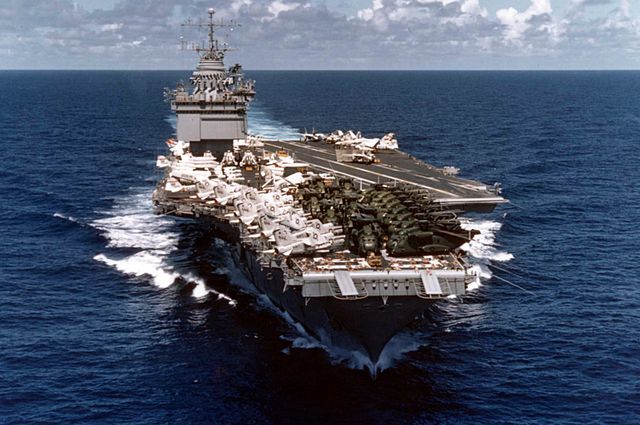
Design
The Nuclear aircraft carrier USS Enterprise (1960), probably the most famous ship of the contemporary US Navy, was also in its time the largest ship in the world, overtaken only by Super-tankers with the 1973-1979 oil crisis, and still remains the largest warship ever built. She was the first to adopt a nuclear propulsion experimented already on USS nautilus submarine (1957) and USS Long beach (1959) but on the much larger scale.
Technically, however, she followed the logical and evolutionary continuation of the Kitty Hawk and Forrestal, but was also was provided with a double ballast hull containing aviation fuel and sea water, with dimensions allowing to accommodate the largest modern jet park ever. She received a combination of the latest radars, including the SPS 32 giving it its imposing radome. Started at Newport News in February 1958, she was launched in 1960 and accepted into service in November 1961. At that time while completing she confirmed the US as the world’s dominant naval superpower. She was planned to be fitted with Terrier missiles, but the latter, heavy and expensive, were never mounted, and instead by 1967 she received Sea Sparrows.
Career
Her career was well filled since he participated in the Mercury program, serving as a relay station for the capsule containing Astronaut John Glenn during his flight in 1962, he was then assigned to the Mediterranean, then participated in the case of missiles from Cuba, then returned to the Mediterranean and made with TF1 (Task-Force One, also including the Long Beach and the Bainbridge) a world tour in 1964 (see below). The “Big E” was engaged in Viet-nâm, its aircraft carrying out attack missions by the Viet-Cong forces on Bien Hôa in 1965. In 1968 an accidental missile explosion killed 27 men but the fire was brought under control. After overhaul at Pearl Harbor she returned to Tonkin, operating with the TF71. It will carry out still other exits until 1972 on this sector. In 1973 she underwent major works to receive the new F-14 Tomcat fighter. In 1975 he set up helicopters to save civilians in Saigon before the arrival of the Khmer Rouge.
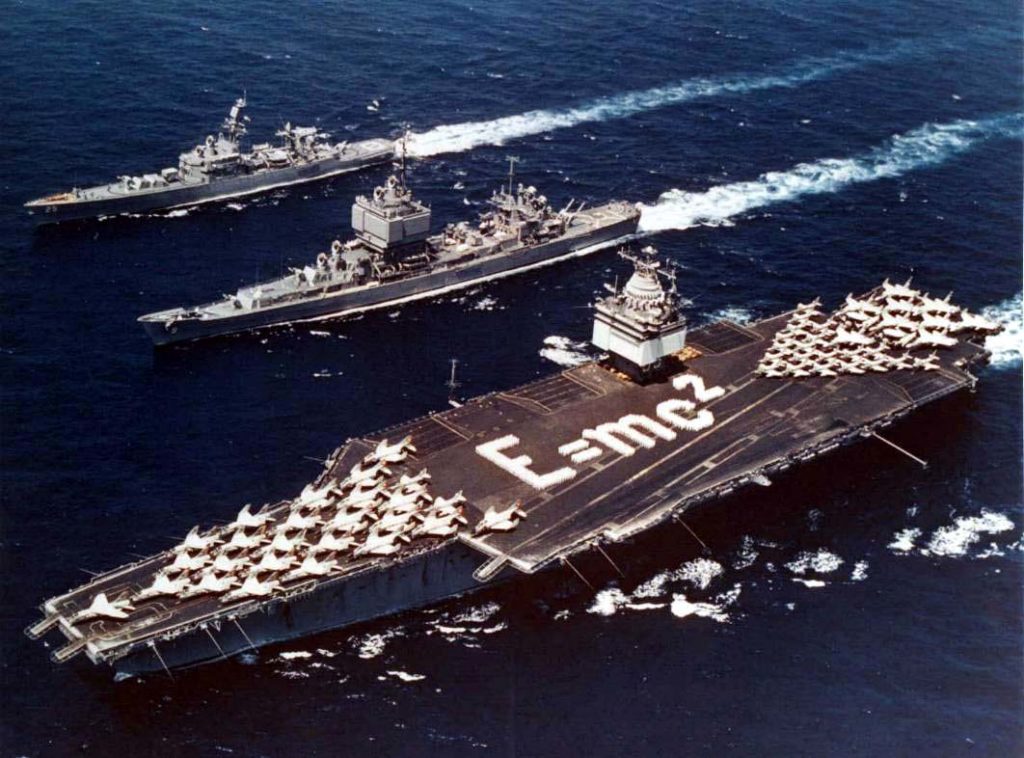
She was implemented an integrated central tactical ASCAC system and satellite antennas from 1976. In addition to her Sea Sparrows she was equipped with three fast Phalanx guns. In 1991, USS Enterprise went through a major overhaul. She received new radars, a third Sea Sparrow launcher, a new NTDS, a TFCC, and her reactor core was replaced. Since then, USS Enterprise (name retaked in the Star Trek series) saw service in the Med and Persian Gulf, participated in operations such as Enduring Freedom against Iraq in 200 and served as a test bed for the Nimitz, the next generation. She was placed in reserve in 2014-2015.

Author’s rendition of the Enterprise class
The USS Enterprise (CVAN-65) was a nuclear-powered aircraft carrier in the United States Navy. She was the world’s first nuclear-powered aircraft carrier and the eighth United States naval vessel to bear the name Enterprise.
Commissioned in 1961, the USS Enterprise served for over 50 years before being decommissioned in 2012. During her long service, she played a significant role in the Cuban Missile Crisis, the Vietnam War, and the Global War on Terror.
The Enterprise was 1,123 feet long and had a displacement of around 94,000 tons. She was powered by eight nuclear reactors, which gave her a top speed of over 30 knots. The carrier had a crew of around 4,600 and could carry up to 90 aircraft.
The USS Enterprise underwent several major overhauls and modernization programs during her service, including the addition of an angled flight deck, steam catapults, and an island superstructure. She also served as a test platform for various naval aviation technologies, including the first carrier-based launch and recovery of unmanned aerial vehicles (UAVs).
The USS Enterprise was decommissioned in December 2012 and was officially inactivated in February 2017. Despite various efforts to preserve the ship as a museum, she was eventually dismantled and recycled.
Characteristics (original):
Displacement: 61 163t, 78 509t PC.
Dimensions: 316.7 x 76.2 x 10.3 m
Propulsion: 4 HP turbines, 8 Babcock boilers, 4 propellers, 280,000 hp. and 33 knots max.
Crew: 2764 + 1912 (officers and sailors, air personnel)
Electronics: Radars SPS-8, 12. SPS58 (Sea Sparrow)
Armament: 8×1 76 mm AA, air group of 80-90 aircraft.
Armament (after modernization): 60 aircraft.
 Nimitz class aircraft carriers (1972)
Nimitz class aircraft carriers (1972)

These nuclear powered carriers currently form the backbone of the US Navy. In 1990, when the USSR fell, there were five in service: USS Nimitz, Dwight D Eisenhower, Carl Vinson, Theodore Roosevelt, and Abraham Lincoln. Three more were under construction, five more would be built in total.
Five years had passed since the entry into service of the USS Enterprise, the first nuclear aircraft carrier, when it was decided in 1968 to start construction of the first of this new series, based on much more compact A4W reactors. Consequently, these shorter, but wider and heavier vessels were also paradoxically more spacious and incorporated an effective ASM protection modeled on that of the USS Kennedy. Giving up the massive radome of the SPS-32/33 fixed antenna, they preferred the SPS-43A and 48 mobile antennas. Their aerial complement was also 90 aircraft, and their configuration of catapults, landing strip and elevators remained classic. Their close defense against planes was ensured by sea Sparrow launchers.
Their armor was reinforced with Kevlar in many places, with the navy attesting that they were able to survive damage three times greater than that received by the Essex-class aircraft carriers in 1944-45. Their fuel load was also much higher and these ships were equipped with the ASM ASCAC fight coordination system. From USS T. Roosevelt, armor and protection were even reinforced, to the detriment of the fuel load. These aircraft carriers, of which the last, USS George H.W. Bush CVN-77 (comp. 2009), succeeding John C. Stennis, Harry Truman and Ronald Reagan, are currently deployed in all sensitive sectors assigned by the United States government. Since the early 2000s, several projects were under study for the replacement of the old Forrestal and Kitty Hawk by more modest ships, studies taking into account the observation of the last aircraft carriers built in Europe and cancelled, but recycled into the Principe de Asturias type.
Eventually it was back to a brand new supercarrier design, even larger, the Gerald Ford class.

Author’s rendition of the Nimitz class
The Nimitz class is a class of nuclear-powered aircraft carriers used by the United States Navy. It is named after the legendary World War II naval commander, Admiral Chester W. Nimitz. The Nimitz class is currently composed of ten active carriers: USS Nimitz (CVN-68), USS Dwight D. Eisenhower (CVN-69), USS Carl Vinson (CVN-70), USS Theodore Roosevelt (CVN-71), USS Abraham Lincoln (CVN-72), USS George Washington (CVN-73), USS John C. Stennis (CVN-74), USS Harry S. Truman (CVN-75), USS Ronald Reagan (CVN-76), and USS George H.W. Bush (CVN-77).
The Nimitz class carriers are the largest warships in the world and are considered the backbone of the United States Navy’s carrier strike groups. They are approximately 1,100 feet long and have a displacement of around 100,000 tons. They are powered by two nuclear reactors and can achieve a top speed of over 30 knots. The carriers have a crew of around 6,000 and can carry up to 90 aircraft.
The Nimitz class carriers have seen extensive service since the commissioning of the lead ship, USS Nimitz, in 1975. They have participated in various conflicts and operations, including the Gulf War, the Iraq War, and Operation Enduring Freedom. They have also served as flagship vessels and played a key role in projecting American power across the globe.
Despite their age, the Nimitz class carriers remain the most powerful warships in the world and are expected to remain in service until the 2050s, with a planned service life of 50 years. The USS Gerald R. Ford (CVN-78), the lead ship of the new Gerald R. Ford class of aircraft carriers, has been commissioned and is expected to replace the older Nimitz class carriers in the coming years.
Characteristics (original):
Displacement: 74 000t standard, 92 000t PC
Dimensions: 331,7 x 78,5 (LF 40,8) x 11,5 m.
Propulsion: 4 shafts HP turbines nuclear 260,000 hp. 32 knots.
Crew: 5620 (officers and sailors, air personnel)
Electronics: Radar SPS-43A, SPS-48.
Armament: 3×8 Sea Sparrow AA (24 v), 3-4 x 20 mm Vulcan-Phalanx CIWS AM, 90 planes.
 Gerald R. Ford class: Design process and ships
Gerald R. Ford class: Design process and ships
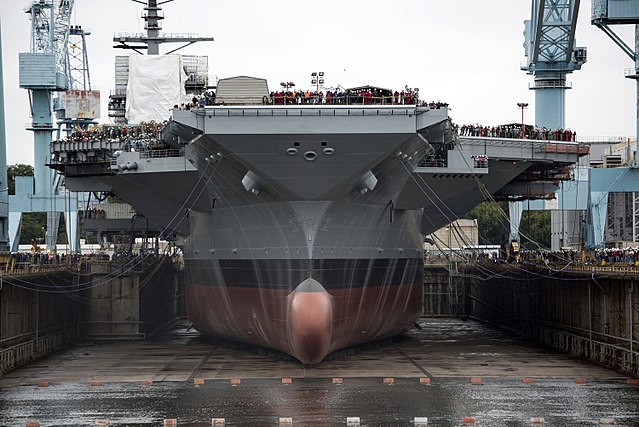
The Gerald R. Ford class is a new class of nuclear-powered aircraft carriers used by the United States Navy. The lead ship, USS Gerald R. Ford (CVN-78), was commissioned in 2017, and the second ship, USS John F. Kennedy (CVN-79), is expected to be commissioned in 2024.
The Gerald R. Ford class carriers are the most advanced aircraft carriers ever built, featuring many new technologies and design changes compared to the older Nimitz class. The carriers are approximately 1,100 feet long and have a displacement of around 100,000 tons. They are powered by two nuclear reactors and can achieve a top speed of over 30 knots. The carriers have a crew of around 4,500 and can carry up to 75 aircraft.
One of the most significant changes in the Gerald R. Ford class carriers is the Electromagnetic Aircraft Launch System (EMALS), which replaces the older steam-powered catapults used on the Nimitz class carriers. The new system uses electromagnetic fields to launch aircraft, which is more efficient, reduces wear and tear on the aircraft, and allows for more precise control over the launch process.
The Gerald R. Ford class carriers also feature advanced radar systems, improved weapons systems, and a new island superstructure design that improves visibility and allows for a smaller crew. The carriers also have enhanced flight deck operations, including the use of autonomous aircraft handling and advanced aircraft launch and recovery systems.
The Gerald R. Ford class carriers are expected to remain in service for at least 50 years, and they will play a vital role in projecting American military power across the globe. The third ship of the class, USS Enterprise (CVN-80), is currently under construction and is expected to be commissioned in the late 2020s.
Characteristics:
Displacement: 61 163t, 78 509t PC.
Dimensions: 316.7 x 76.2 x 10.3 m
Propulsion: 4 HP turbines, 8 Babcock boilers, 4 propellers, 280,000 hp. and 33 knots max.
Crew: 2764 + 1912 (officers and sailors, air personnel)
Electronics: Radars SPS-8, 12. SPS58 (Sea Sparrow)
Armament: 8×1 76 mm AA, air group of 80-90 aircraft.
Evolution of cold war USN aircraft carriers
WW2 Rebuilts
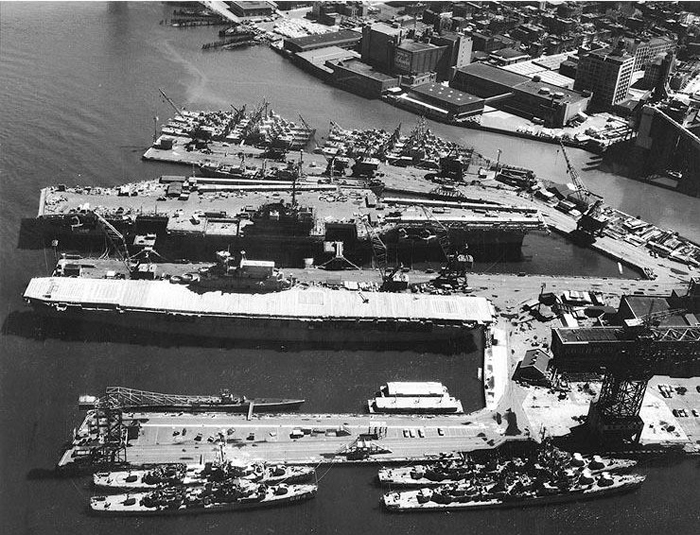
The old guard vs. the new one: USS Enterprise (CV-6) awaiting disposal at the NY Naval Shipyard close to USS Independence (Forrestal class) fitting out on 22 June 1958
Of the 8 interwar aicraft carriers (USS Langley, Lexington class, Ranger, Yorktown class, Wasp), for 4 losses, none was considered fit for longer service. It’s a shame however that a ship so remarkable as USS Enterprise (CV-6) was not kept as museum ship, but back in 1958 when it was decided to scrap her, that was not yet a priority.
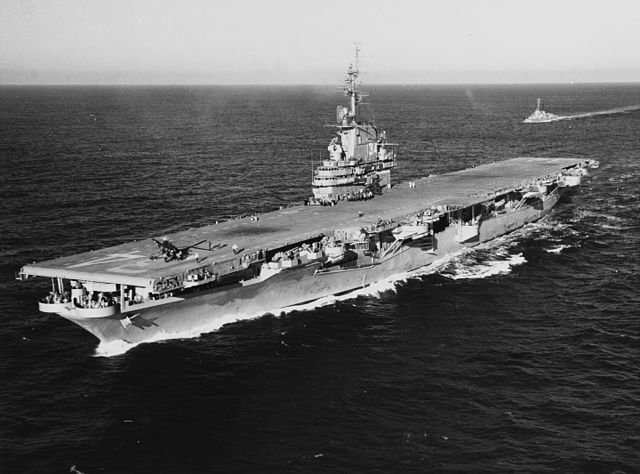
USS Oriskany as completed in 1950. She was the blueprint for subsequents modernizations and was the very last Essex in service (1990).
However in WW2, from the numerous Essex hulls laid down (32 planned, 24 completed, 8 cancelled), two were write-offs following kamikaze attacks, and the rest underwent a serie of modernizations, with retrofits as detailed beforehand. They were large enough to be of some use, and most saw both the Korean and Voetnam war, either to carry helicopters for assault or ASW patrols, and the ones most modified operated light jets of the intermediate generation (the typical park comprised the A4 Skyhawk and A1 Skyraiders – see air groups). The only one with a significant air park, and most modernized of the whole serie, USS Oriskany had in 1973 the following: 24 F-8J Crusader fighters, 36 A-7B Corsair attack aicraft, 4 RF-8G Crusader (recce), 4 E-1B Tracer (ASW), 3 EKA-3B Skywarrior (EW), 4 SH-3G Sea King (SAR/ASW).
The USMC LPH conversion, forerunner of the assault carrier and later LPD, carried 30-40 helicopters of the HUP, HO4S/HRS Chickasaw, HO5S, HUS Seahorse, and HR2S Mojave types.
![]()
USS Ticonderoga (CVS-14) passing htough the sunds strait on 24 April 1971. This was her last appearance as she was Sold to DRMS and scrapped in September 1975.
The case of the Midways is more interesting. This later generation also built in WW2 but completed too late, were the first true armoured carriers of the USN, designed to face kamikaze attacks. Between their immense size and reinforced deck, catapults and lifts, they proved perfectly able to do the postwar conversion to jets, seeing for USS Midway, the only one truly modernized twice, the capability to operate all generations of jets in the USN, but not the largest aircraft in the park, like the A5 Vigilante. During the gulf war in 1991, her last deployment, USS Midway operated the following: 36 F/A-18 Hornet fighters, 12 A-6E/KA-6D Intruder attackers, 8 EA-6B Intruder, 4 E-2C Hawkey, 3 C-2A Greyhound transport, 4 SH-3H Sea King ASW/SAR helicopters.
Were there the US taxpayer’s money most efficient ships ? In some way, yes by their career, but no, concerning USS Midway. Her SBC 101.66 modernuzation was almost as costly as a newly built carrier, and not ported to her two sister as initially planned. The Essex were not as cheaply modernized either as some had three successive reconstructions and only one survived to the 1980s.
Compared to them, the first eight conventional supercarriers were in service longer without much upgrades, and at a construction cost well below the CVNs.
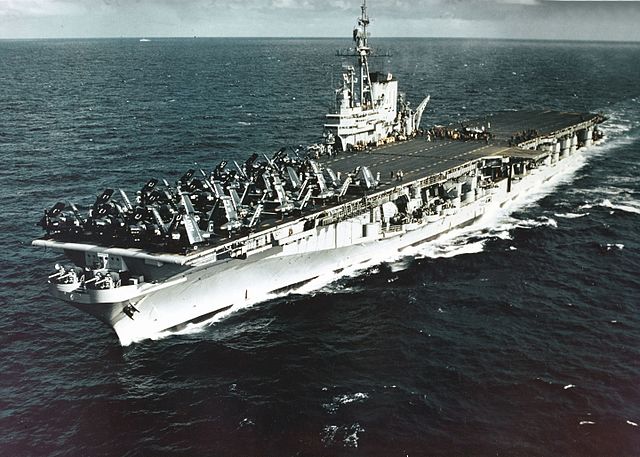
USS Midway (CVB-41) in the firth of forth, 1952
The first supercarriers

Every carrier was class was very specific. The Lexingtons in the 1920s were the first fleet carriers and ships conversions, the Ranger was an exploratory design to see if a very low tonnage vessel could use a practicable carrier group, the three Yorktown were mature fleet carriers, Wasp was a “demi-fleet carrier” designed to “spend” remaining peacetime tonnage. The Essex were wartime fleet carriers, freed from treaties and the Midways were the first armoured carriers.
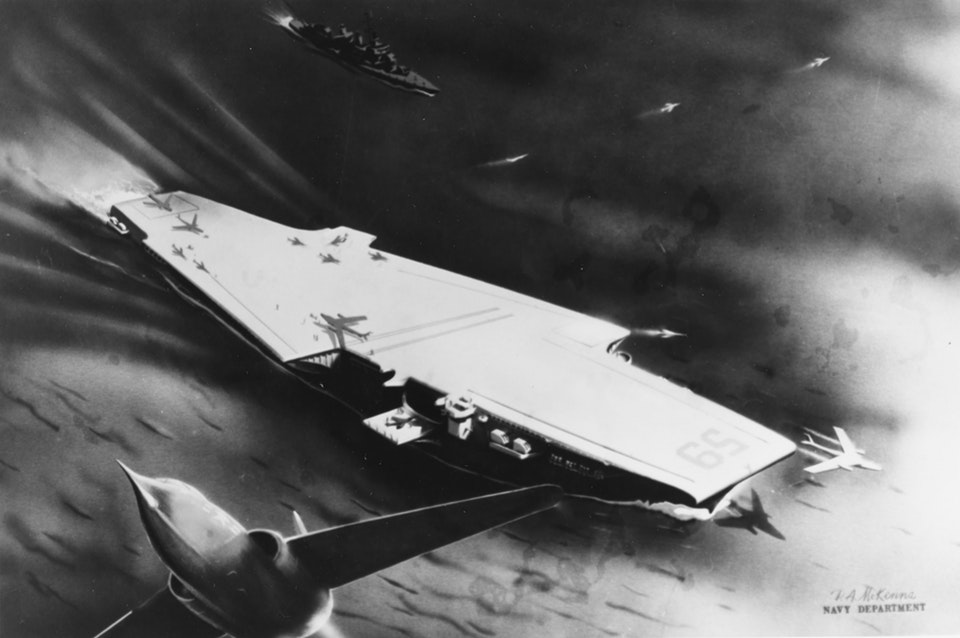
Artists impression of the USS United States (see later)
Next, the USS United States was an unbuild “atomic delivery” carrier, designed to carry navy bombers atomic strikes, until the Air Force won the contest and had the ship scrapped. Instead, the navy recentered in what were her first post-WW2 designs, the conventional eight “supercarriers” of the 1950s: The Forrestals and Kitty Hawks. The USS Enteprrise was a prototype nuclear-powered aircraft carrier and the following Nimitz, a smaller, more rational and cheaper class of the same (CVNs). Until the Gerald Ford, the design changed little since the 1970s.
The USN today is still sysnonimous with her fleets posted around the world, all centered around such supercarrier, and numerous escorts, both national and international, through NATO and under other partnerships.
The term “supercarrier” was coined by the press in the 1950s as a way to distinguish these new constructions from the already colossal Midway class by their unprecedented tonnage (75,000 tons). It never was used officially. In fact their indicative was not changed to mark any difference, still CV. It evolved however for the unbuilt United States, as “CVA”, with the last letter standing for “atomic” (capabilities). It was different from the CVN of USS Enterprise, which still used the follow-up numeration, and went on with the next Nimitz class, the “N” standing for nuclear (power).
The Navy eventually get back some atomic capabilities under some conditions in the 1970s.
The trademark of the supercarrier was, apart its enormous scale, tailored to carry and operate modern jets, larger and heavier than previous piston-engine models, and integrate all the latest in carrier innovations between the angle deck, side deck lifts, more powerful capatults, more fuel, more hangar space… They did not required much alterations but in electronics and armament over their long service years, sporting all the exiting park of USN aircraft and helicopters from the 1950s to the 1990s. They were still valid for extra service years but the post-cold war budget cust pressed their end. It was true also for the USS Enteprise, which served for three decades but was too costly to operate.
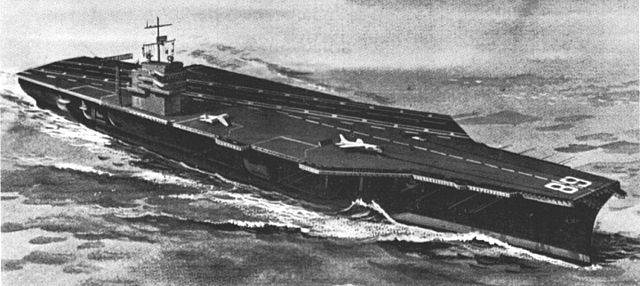
Artist Impression of the Nimitz class aircraft carriers
The Nimitz class were still no longer called “supercarriers”, but only in some circles as a way to compare them to other nation’s carriers, between Russia, France or Britain, certainly smaller.
The latest Gerald R. Ford are not much different than the Nimitz, but with experience, had a well streamling deck operation scheme, better electric catapults, better electronics with advanced communication as well as C&C facilities than ever before, everything needed to coordonate the perfect integration in combat and answer to any threat by a multinational fleet. The more conservative part is the aviation, which still sports today more or less the same models as in the 1990s, so thirty years before: Notably the F-18 Hornet, F-2 Hawkeye, Prowler and others, as well as experimenting with large naval drones. Given the number of Gerald Ford ships already in construction or in future schedule, as a per-one basis, despite hypersonic missiles and other new threats, it seems the USN firmly believes in the Aircraft Carrier of the centerpiece of its doctrine for the foreseeable future.
Some authors dared to say the tank was died in Ukraine recently, but the aircraft carrier is certainly not seen as a dying type as the battleship was. Internationally, new nations are building new carriers. In Europe, after the two large conventional carriers of Britain, France is gearing towards a large CATOBAR nuclear carrier, closer to the “supercarrier” standard. China is going the same way and India is studying a ship to catch-up also. Even in Japan, the taboo about large aircraft carriers seems lifted, and its officially large “helicopter destroyers” are everything but. This new arms race is the fruit of growing tensions in the China Sea.
Naval carrier-borne Aviation
This category is specific and recoups also helicopters. Indeed, if the past and current aircraft carriers called CATOBAR (no ramp, but catapults) could operate a large variety of models, operating at full load, smaller specialized carriers such as the LPH-LPD used for amphibious operations as shown in Korea and Vietnam, possesses also both helicopters and aircraft (VTOL like the AV-8B Harrier 2 and now F-35), but also converted types like the V-22 Osprey. Together, they offers a wide variety of possibilities to the USMC, the Marine Corps. The Av8B could provide some air defence, as its military payload is limited to support operations. The F-35 will largely do better in all areas.
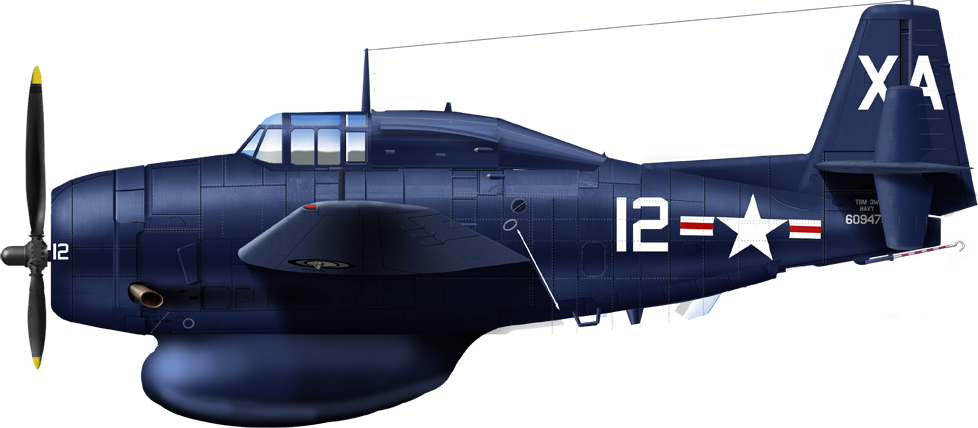
“Legacy” WW2 models were still flying in the 1950s, like this Grumman TBM-3W Avenger completely redesigned for ASW warfare. It was replaced by the Guardian, Tracker and finally jet-powered Viking. Today these missions are performed by helicopters.(author’s)
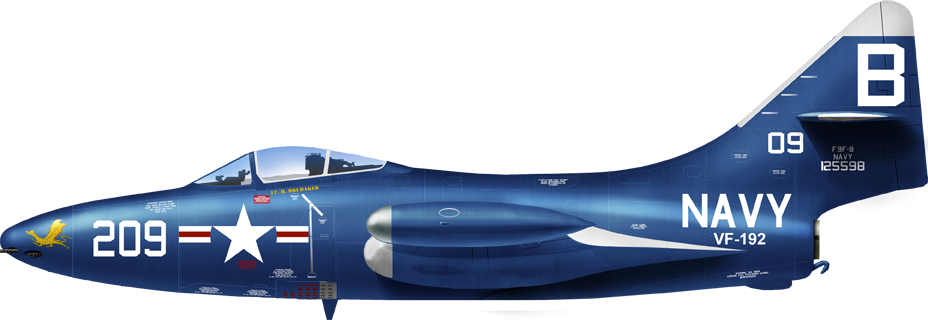
The Grumman F9F Panther (first flight 1947) represented the early jet generation. They were much lighter than most 1960s models such as the F4 Phantom. The Panther was used in the USN until 1958. Here an F9F-2 from uss oriskany Sept. 1953, Korean War -the one in “bridge of toko-ri” (author’s)

The twin-seat, twin engine, heavy payload McDonnell Douglas F-4 Phantom II (1st flight 1958) carried the bulk of operations in Vietnam and into the late 1970s for the USN. Versions were also operated by the Royal Navy on its own CATOBAR carriers. It represented the new generation of radar/missile platforms first, in contrast to the earlier F-8 Crusader, dubbed “the last dogfighter”. Here a F4J from VF-92, USS Constellation -Kitty Hawk class (Tom Cooper).

Author’s rendition of the North American A5A Vigilante, VAH-7 “Peacemakers”, CVAN-65, 1962. The largest carrier jet operated by any nation. (author’s)

F14A from VF-33, USS America. First and only swing-wing figher in the USN, this last “pure Grumman” model first flew on 1970, and represented the US Superiority Figher for three decades, until the 1990s, winning over the competing “sea eagle” (Tom Cooper).

McDonnell Douglas FA-18C Hornet from VFA-81, USS Saratoga. The last generation of fighter bombers of the USN and absolutely central to today’s air operations. The Hornet first flew in 1978, and is still currently in service after 45 years, and many, many upgrades. The current Boing F/A-18E/F Super Hornet (1995) is schedule to serve at least until the mid-2030s (production stop in 2025). Plans to replace it by the F-35B are ongoing (Tom Cooper).
Of course these models only represents the “sexiest” of the bunch, the USN heavily depends on less glamorous but necessary models for other missions: Attack (with models such as the Vought Corsair II) ASW (anti-sub marine warfare), EW (Electronic warfare) and electronic surveillance, transport, and SAR (search and rescue).
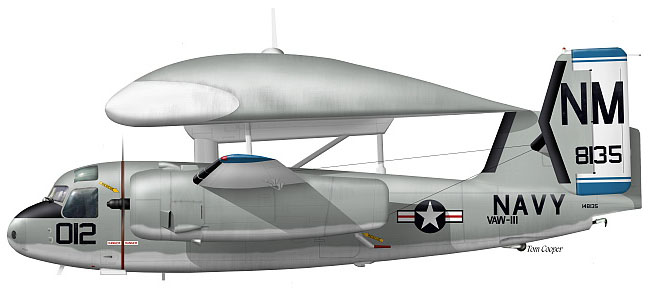
Grumman E1B Tracer. This model first flew in 1958 and served until replacement by the E2 Hawkeye from 1964. So it had a short service span, but brought to the Navy a long range airborne early warning capability, well beyond the range of radars.

SAN DIEGO, Calif. (April 24, 2008) “The Raptors” of HSM-71 fires off the first of four live Hellfire shots by a deployable squadron. Prior to this event, the only Romeo Hellfire shot was at the test and evaluation squadron VX-1. The AGM-114 series Hellfire missile is a laser-guided precision air-to-surface missile. The army originally developed the missile as an anti-tank weapon, and the Navy currently uses in order both water and land as a stand off attack weapon. U.S. Navy photo by Mass Communication Specialist 2nd Class Mark A. Leonesio (RELEASED)
Since the floatplanes are long gone, helicopters are devoluted the SAR, liaison and ASW role. The HRS, HUP, HSS, HUS, HOK, HUK, HUL, and HR2S helicopters were always part of these aircraft carrier’s park, always two to six or more. Today, the Sikorsky SH-60 is the mainstay of rotary-wing parks across Navy Carriers. Models are different on assault ships (see later) as they are owned and operated by the USMC.
USN Assault Carriers

The USMC already used aircraft carriers during the WW2 Pacific Campaign: They were however operated by the USN. These were small escort carriers, such as those of the Casablanca and Commencement Bay classes, which limited air group was tasked of ASW patrol around the landing area as well as reconnaissance, CAP (air defence) and ground support. But the amphibious operations were made by completely different ships, assault transport bristling with landig crafts under davits and other types.
Experimentations went on and the best types in operations appeared to have been the LSTs on one hand and the LSDs (Landing Ship Dock) on the other. The first were tailored to land heavy hardware on the beach, the second to land troops in a faster and less tiedous way than traditional assault transports: The landing crafts were inside a built-in “drydock” enabling their quick departure at sea level instead of the long process of lowering these under davits and use nettings to allow the infanty to embark, always a dangerous situation. What relation to aviation ?
Some in the 1950s speculated that the helicopter was a new asset than can land and depart from any deck, even the smallest, and if the early Iwo Jima were pure helicopter carriers for heliborne assault, ready for Vietnam (operated by the USMC), and inspired by converted Essex-class carriers, the following ships were combination of both the LPH and LSD, with large decks for heliborne assault comleting the beach assault by landing crafts. The following classes were tailored over time to operate VTOL aicraft as well as helicopters, and thus, qualifies in my book as “aircraft carriers” even though they are specialized assault vessels.
 Iwo Jima class (1960)
Iwo Jima class (1960)

The Iwo Jima class was a class of amphibious assault ships (LPH) used by the United States Navy in the 1960s and 1970s. The class consisted of two ships: USS Iwo Jima (LPH-2) and USS Okinawa (LPH-3).
The Iwo Jima class was developed to support amphibious operations during the Cold War, particularly in response to the growing threat of communist expansion in Southeast Asia. The ships were designed to transport and deploy troops, equipment, and helicopters to support amphibious landings and other operations. They were also capable of providing medical support and operating as a mobile command center.
The ships had a displacement of approximately 18,300 tons and were powered by steam turbines, which gave them a top speed of around 22 knots. They had a crew of around 1,200 and could carry up to 3,000 troops, as well as up to 30 helicopters. The ships were armed with a variety of weapons, including 20mm and 40mm anti-aircraft guns and 5-inch/54 caliber guns.
The Iwo Jima class ships saw extensive service during the Vietnam War, where they played a vital role in transporting troops, supplies, and helicopters. They also participated in a variety of other operations and exercises throughout the 1960s and 1970s.
Both ships were eventually decommissioned in the 1990s and replaced by the Wasp class amphibious assault ships. However, the Iwo Jima class played an important role in the development of modern amphibious warfare ships and helped establish the United States Navy’s ability to support amphibious operations around the world.
 Tarawa class (1973)
Tarawa class (1973)

The Tarawa class was a class of amphibious assault ships (LHA) used by the United States Navy in the 1970s and 1980s. The class consisted of five ships: USS Tarawa (LHA-1), USS Saipan (LHA-2), USS Belleau Wood (LHA-3), USS Nassau (LHA-4), and USS Peleliu (LHA-5).
The Tarawa class was developed as a replacement for the Iwo Jima class and was designed to transport and deploy troops, equipment, and helicopters to support amphibious landings and other operations. They were also capable of providing medical support and operating as a mobile command center.
The ships had a displacement of approximately 39,000 tons and were powered by steam turbines, which gave them a top speed of around 24 knots. They had a crew of around 2,000 and could carry up to 1,800 troops, as well as up to 31 helicopters and a variety of amphibious vehicles. The ships were armed with a variety of weapons, including Phalanx close-in weapon systems, 20mm and 40mm anti-aircraft guns, and 5-inch/54 caliber guns.
The Tarawa class ships saw extensive service during the Gulf War, where they played a vital role in transporting troops, supplies, and helicopters to support the coalition forces. They also participated in a variety of other operations and exercises throughout the 1980s and 1990s.

All five ships were eventually decommissioned in the early 2000s and replaced by the larger and more advanced Wasp class amphibious assault ships. However, the Tarawa class played an important role in the development of modern amphibious warfare ships and helped establish the United States Navy’s ability to support amphibious operations around the world.
 Wasp class (1987)
Wasp class (1987)

The Wasp class is a class of amphibious assault ships (LHD) used by the United States Navy. The class consists of eight ships: USS Wasp (LHD-1), USS Essex (LHD-2), USS Kearsarge (LHD-3), USS Boxer (LHD-4), USS Bataan (LHD-5), USS Bonhomme Richard (LHD-6), USS Iwo Jima (LHD-7), and USS Makin Island (LHD-8).
The Wasp class was designed to replace the aging Tarawa class and was designed to transport and deploy troops, equipment, and helicopters to support amphibious landings and other operations. They are also capable of providing medical support and operating as a mobile command center.
The ships have a displacement of approximately 41,000 to 45,000 tons and are powered by gas turbines, which give them a top speed of around 22 knots. They have a crew of around 1,200 and can carry up to 1,800 troops, as well as up to 31 helicopters and a variety of amphibious vehicles. The ships are armed with a variety of weapons, including Phalanx close-in weapon systems, Rolling Airframe Missile (RAM) systems, and 25mm and 7.62mm machine guns.

The Wasp class ships have seen extensive service, including participation in the Gulf War, the Iraq War, and the War in Afghanistan. They have also participated in a variety of other operations and exercises around the world.
The Wasp class has been the primary class of amphibious assault ships in the United States Navy since the 1980s, and the ships have been continually upgraded and improved to maintain their effectiveness in modern warfare.

USMC MV-22B Osprey, the current tiltrotor heavy transport operated from large assault ships. Development since the 1980s has been protracted, complicated and controversial, but the final product is really a game changer. The newly developed army’s V280 Valor, which has to replace the Blackhawk is also a tiltrotor.
Aircraft carrier projects
USS United States (1949)
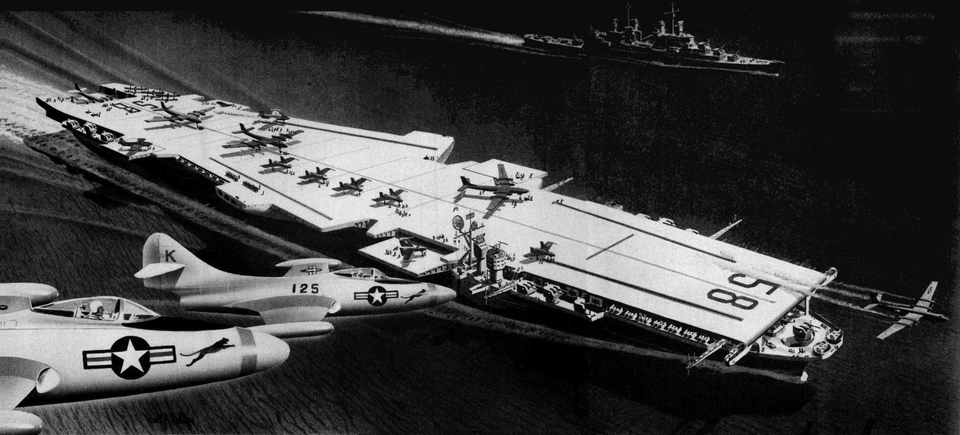
USS United States (CVA-58) was a proposed aircraft carrier of the United States Navy, planned to be the lead ship of her class. The ship was originally intended to be a larger and more capable successor to the Essex class, which had been the backbone of the Navy’s carrier force during World War II.
Construction of the United States began in 1949, but was later canceled in 1949 due to budget constraints and changing strategic priorities. At the time of her cancellation, the ship was approximately 45% complete.
The United States was intended to be 1,080 feet long and displace around 70,000 tons. She was designed to be powered by four General Electric turbines, which would have given her a top speed of over 35 knots. The ship was also designed to carry a complement of over 100 aircraft, including fighters, bombers, and reconnaissance planes, but was mostly intended to deliver atomic bombers, until the ait force/navy rivalry was won by the latter at the White House and pushed for cancellation.
Had she been completed, the United States would have been the largest and most powerful aircraft carrier in the world at the time, and would have represented a major leap forward in naval aviation technology. However, the cancellation of the ship was a reflection of the changing strategic priorities of the United States in the early years of the Cold War, as well as the increasing cost and complexity of modern naval technology.
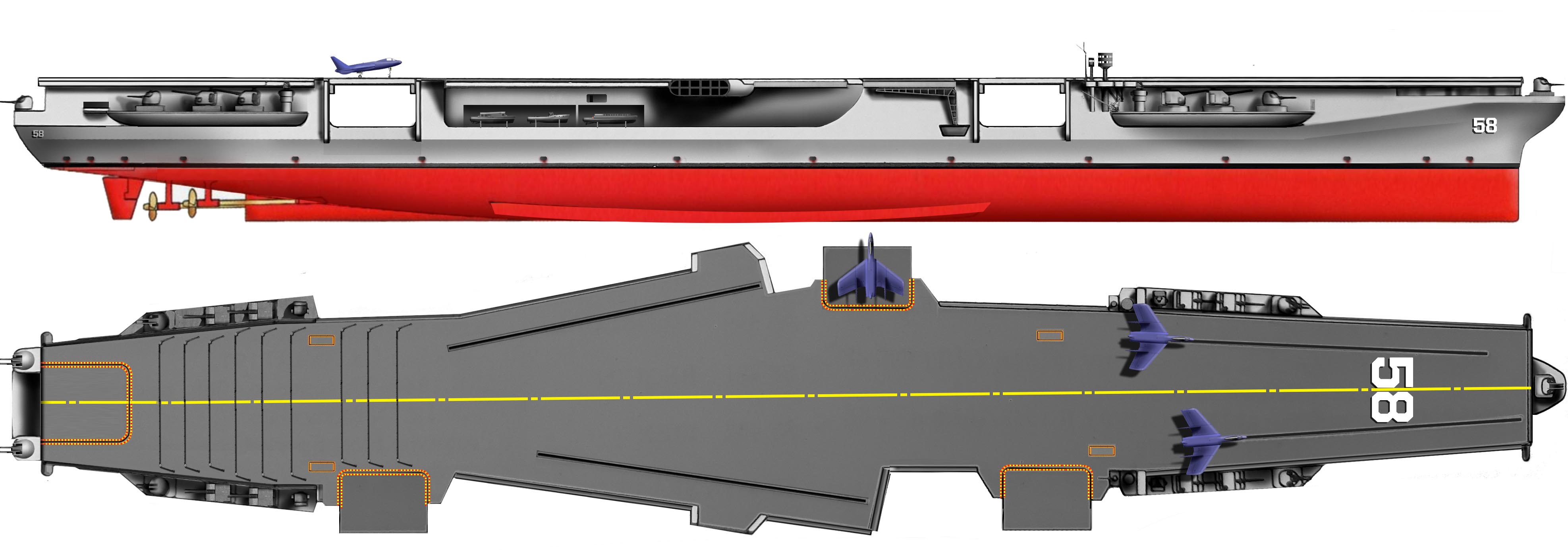
SCS class aircraft carriers (1969)
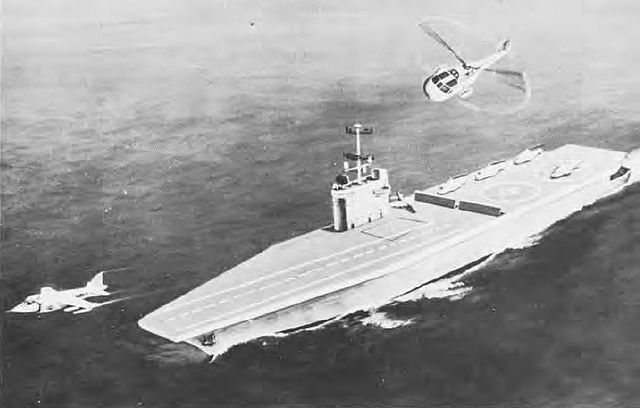
The Sea Control Ship (SCS) were a projected small aircraft carrier design developed and conceptualized under Chief of Naval Operations Elmo Zumwalt. Currently the term refers to ships performing similar duties. They were intended as escort carriers liked those of WW2, providing air support for convoys. The project was canceled after budgetary cuts to the US Navy.
The SCS was to be equipped with a mix of also projected Rockwell XFV-12 VTOL fighter aircraft and ASW helicopters and mostly capable anti-submarine warfare operations.
In the late 1960s, studies led by the US Navy identified a potential requirement for convoy operations in the event of war with the Soviet Union. An equivalent of WW2 escort carriers. Regular escort ships, notably frigates such as the Knox class and earlier could carry helicopters, but they could be in short numbers in case of a concerted “wolfpack” type attack.
It was suggested that helicopters from small helicopter carriers, not unlike the Iwo Jima ships developed at the same time for the USMC, could perform thiese tasks.
Elmo Zumwalt became the new Chief of Naval Operations (CNO) in 1970, and revived the small helicopter carrier idea as part of his “High-Low” plan for cheaper, lower capability ships to complement larger and costier vessels. The program was named eventually the Sea Control Ship (SCS), and the requirements were to provide ae continuous airborne cover, prescely set to two anti-submarine, one airborne early warning helicopters at all time, but also to carry VSTOL fighters to deal with Soviet bombers such as the Tupolev Tu-95 “Bear” from shadowing convoys and directing submarines. The final specifications asked for 14 helicopters (to have at least one trio in the air, one preparing to take off, one in maintenance, the rest as spares) and three VSTOL fighters which later was assigned to the AV-8 Harrier once the ambitious XFV-12 program was terminated. Each was budgeted for no more than $100 million which was 1/8 of a Nimitz-class ship at the time. Full load displacement was to be 13,736 long tons (13,956 t), overall length 610 feet (190 m). Propulsion was assumed to be two General Electric LM2500 gas turbines for 45,000 shaft horsepower (34,000 kW) on a single shaft, enough for 26 knots (48 km/h; 30 mph). Two Phalanx weapon systems were provided for close defence. It was assumed that the convoy’s guardships should also escort the SCS.
The program was “experimented” in 1971 with USS Guam chosen as test vessel, starting convoy escort operations from 18 January 1972 and by 1974 deployed to the Atlantic Ocean with AV-8A Harrier STOVL fighters and SH-3 Sea King ASW helicopters aboard. By July 1974 it was time for reporting it, and USS Guam resumed its amphibious role tasks.
Eventually the late 1970s budget cuts had reason of the program. The USS Guam experiment indeed showed that regular assault amphibious ships could be deployed for ad hoc escrt missions if needed, and in case of war, more of a simplified version could be built without delays.
VSTOL VSS class aircraft carriers (1974)
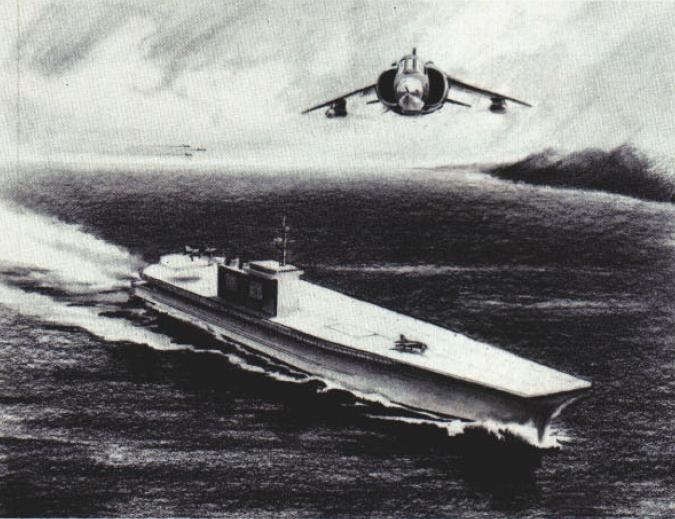
The VSTOL Support Ship (VSS) was a proposed light aircraft carrier that would be smaller and less expensive than the existing supercarriers such as the Nimitz-class. The design was indeed much cramper and only capable of operating V/STOL aircraft such as the AV8B Harrier 2 and helicopters, but it having overall reduced performance. It was born from the SCS project of CNO Elmo Zumwalt, but his austere SCS design was opposed the US Navy istself, notably Admiral Hyman G. Rickover and much of the Naval aviation community, until the US Congress rejected the program in 1975.
New CNO, James L. Holloway III abandoned the SCS but not tthe concept, which had some metits to its eyes. He pushed for a larger, more capable class called the VSTOL Support Ship, or VSS. The development started in June 1976, resulting in a 690 feet (210 m) long ship powered by four General Electric LM2500 gas turbines, twice as much as for the SCS, for 29 knots (54 km/h; 33 mph), more compatible with the fleet. Cacacity was greater with 22 helicopters (16 H-53 Sea Stallions and six LAMPS light helicopters) and four AV-8 Harrier II. Holloway pressed the aviation industry to come up with a better VTOL model to justify his project, essentially a “jack of all trade” capable of interception, ASW, Airborne Early Warning duties. Probably too ambitious it went nowhere. The carrier’s design was reworked in February 1978 and became the VSS II with a larger hangar, greater beam to allow future, larger VTOL models to be carried, and also more avgas capacity.
The third variant called VSS III by July 1978 was a variant with better magazines protection, and to combat extra weight a new hull form was designed, with less freeboard and better speed, at 717 feet (218.5 m) long overall, 178 feet (54.3 m) in beam, 24 feet 4 inches (7.42 m) in draft and a displacement of 20,116 long tons (20,439 t) light, 29,130 long tons (29,600 t) full load. Close defense rested on two quadruple Harpoon SSMs, two Phalanx. This time, the project rallied some in the Navy, but also gained the United States Senate support, but it’s the Navy itself that, also with the aviation community, put a plug on it.
Not all was to be lost however. The millions of US Taxpayer money’s sunk into the SCS project was “recycled” after agreement with the Spanish Government into the Spanish-built aircraft carrier Principe de Asturias, which realized Zumwalt’s vision much better than any amphibious assault ship can. If anything, the concept is not ireelevant in the context of a war with China today.
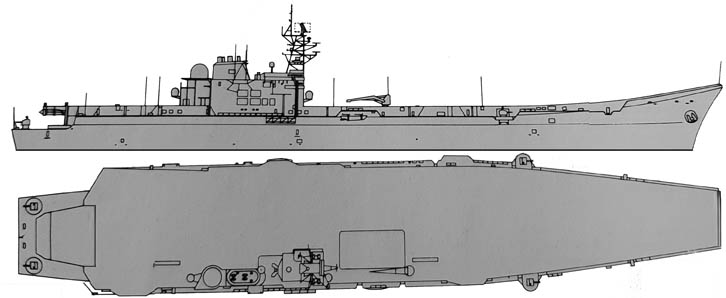
The Principe de Asturias class, partly based on the SCS and VSS projects.
The SCS was in fact well tailored for limited budget nations, and outside Spain Thailand’s HTMS Chakri Naruebet, was also based on final US Navy blueprints for the SCS, both Asturias and this one having ski-jump ramp and generally has the similar mission profile.
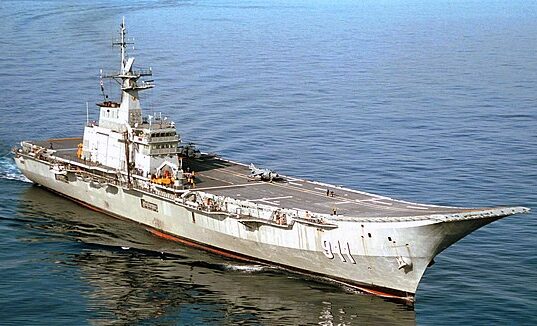
The HTMS Chakri Naruebet in 2001, another illustration of the SCS concept turned into reality. Built in Spain, she can operate 6 Sikorsky SH-60 Seahawk 2(+4) MH-60S Knighthawk and 6 AV-8S (they were retired in 2006)

 Latest Facebook Entry -
Latest Facebook Entry -  X(Tweeter) Naval Encyclopedia's deck archive
X(Tweeter) Naval Encyclopedia's deck archive Instagram (@navalencyc)
Instagram (@navalencyc)





 French Navy
French Navy Royal Navy
Royal Navy Russian Navy
Russian Navy Armada Espanola
Armada Espanola Austrian Navy
Austrian Navy K.u.K. Kriegsmarine
K.u.K. Kriegsmarine Dansk Marine
Dansk Marine Nautiko Hellenon
Nautiko Hellenon Koninklije Marine 1870
Koninklije Marine 1870 Marinha do Brasil
Marinha do Brasil Osmanlı Donanması
Osmanlı Donanması Marina Do Peru
Marina Do Peru Marinha do Portugal
Marinha do Portugal Regia Marina 1870
Regia Marina 1870 Nihhon Kaigun 1870
Nihhon Kaigun 1870 Preußische Marine 1870
Preußische Marine 1870 Russkiy Flot 1870
Russkiy Flot 1870 Svenska marinen
Svenska marinen Søværnet
Søværnet Union Navy
Union Navy Confederate Navy
Confederate Navy Armada de Argentina
Armada de Argentina Imperial Chinese Navy
Imperial Chinese Navy Marinha do Portugal
Marinha do Portugal Mexico
Mexico Kaiserliche Marine
Kaiserliche Marine 1898 US Navy
1898 US Navy Sovietskiy Flot
Sovietskiy Flot Royal Canadian Navy
Royal Canadian Navy Royal Australian Navy
Royal Australian Navy RNZN Fleet
RNZN Fleet Chinese Navy 1937
Chinese Navy 1937 Kriegsmarine
Kriegsmarine Chilean Navy
Chilean Navy Danish Navy
Danish Navy Finnish Navy
Finnish Navy Hellenic Navy
Hellenic Navy Polish Navy
Polish Navy Romanian Navy
Romanian Navy Turkish Navy
Turkish Navy Royal Yugoslav Navy
Royal Yugoslav Navy Royal Thai Navy
Royal Thai Navy Minor Navies
Minor Navies Albania
Albania Austria
Austria Belgium
Belgium Columbia
Columbia Costa Rica
Costa Rica Cuba
Cuba Czechoslovakia
Czechoslovakia Dominican Republic
Dominican Republic Haiti
Haiti Hungary
Hungary Honduras
Honduras Estonia
Estonia Iceland
Iceland Eire
Eire Equador
Equador Iran
Iran Iraq
Iraq Latvia
Latvia Liberia
Liberia Lithuania
Lithuania Mandchukuo
Mandchukuo Morocco
Morocco Nicaragua
Nicaragua Persia
Persia San Salvador
San Salvador Sarawak
Sarawak Uruguay
Uruguay Venezuela
Venezuela Zanzibar
Zanzibar Warsaw Pact Navies
Warsaw Pact Navies Bulgaria
Bulgaria Hungary
Hungary

 Bundesmarine
Bundesmarine Dutch Navy
Dutch Navy Hellenic Navy
Hellenic Navy Marina Militare
Marina Militare Yugoslav Navy
Yugoslav Navy Chinese Navy
Chinese Navy Indian Navy
Indian Navy Indonesian Navy
Indonesian Navy JMSDF
JMSDF North Korean Navy
North Korean Navy Pakistani Navy
Pakistani Navy Philippines Navy
Philippines Navy ROKN
ROKN Rep. of Singapore Navy
Rep. of Singapore Navy Taiwanese Navy
Taiwanese Navy IDF Navy
IDF Navy Saudi Navy
Saudi Navy Royal New Zealand Navy
Royal New Zealand Navy Egyptian Navy
Egyptian Navy South African Navy
South African Navy






























 Ukrainian Navy
Ukrainian Navy dbodesign
dbodesign